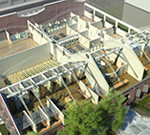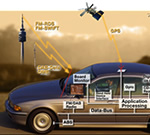Scheduling and Control for Energy Efficeint Building Automation (DoE Energy-Efficeint Buildings HUB) |
 |
Heating, cooling and air quality control systems within buildings and datacenters operate independently of each other and frequently result in temporally correlated energy demand surges. As peak power prices are 200-400 times that of the nominal rate, this uncoordinated activity is both expensive and operationally inefficient. While several approaches for load shifting and model predictive control have been proposed, we present an alternative approach to fine-grained coordination of energy demand by scheduling energy consuming control systems within a constrained peak power while ensuring custom climate environments are facilitated. Unlike traditional real-time scheduling theory, where the execution time and hence the schedule are a function of the system variables only, control system execution (i.e. when energy is supplied to the system) are a function of the environmental variables and the plant dynamics. To this effect this project includes scheduling of energy control systems, sensing-based reduced order modeling of buildings and tools for integrated modeling and controls for energy-efficient buildings. More.
The Department of Energy's HUB on Energy Efficient Buildings received $129 million from the Federal Government's Energy Regional Innovation Cluster (E-RIC) Initiative. The award included $122 million from the U.S. DOE to create the EEB HUB to develop innovative energy efficient building technologies, designs and systems. The EEB HUB goal is to transform the commercial building retrofit and new construction processes into a systems-delivery industry, and demonstrate building operational energy savings of 30% by 2015 in a scalable, repeatable and cost effective manner across a broad building stock, while preserving workplace quality. |
|
Closing-the-Loop with Medical Cyber-Physical Systems (NSF CAREER) |
 |
The design of bug-free and safe medical device software is challenging, especially in complex implantable devices that control and actuate organs whose response is not fully understood. Safety recalls of pacemakers and implantable cardioverter defibrillators between 1990 and 2000 affected over 600,000 devices. Of these, 200,000 or 41%, were due to firmware issues (i.e. software) that continue to increase in frequency. There is currently no formal methodology or open experimental platform to test and verify the correct operation of medical device software within the closed-loop context of the patient. Our efforts are on developing the foundations of modeling, synthesis and development of verified medical device software and systems from verified closed-loop models of the device and organs. The research spans both implantable medical devices such as cardiac pacemakers and physiological control systems such as drug infusion pumps which have multiple networked medical systems. In both cases, the devices are physically connected to the body and exert direct control over the physiology and safety of the patient. With the goal to develop a tool-chain for certifiable software for medical devices, I will walk through (a) formal modeling of the heart and pacemaker in timed automata, (b) verification of the closed-loop system, (c) automatic model translation from UPPAAL to Stateflow for simulation-based testing, and (d) automatic code generation for platform-level testing of the heart and real pacemakers. More. |
|
Networked Automotive Cyber-Physical Systems (UPenn-CMU Tier-1 University Transportation Center, funded by Department of Transportation) |
 |
The automobile of the future will be programmable for network-based active safety, real-time traffic congestion prediction and remote vehicle diagnostics and updates. To realize this goal, our efforts focus on three contributions toward the foundations of Automotive-CPS: (a) AutoPlug - An Open Automotive Platform for Electronic Controller Unit (ECU) testing, and verification for remote recalls management; (b) GrooveNet - a vehicle-to-vehicle network virtualization platform that enables communication between hundreds of virtual vehicles and real vehicles for active networked safety, and (c) AutoMatrix - a GPU-based vehicular traffic congestion simulator that can simulate over 16 million vehicles for real-time traffic congestion probing, prediction and fastest-path route assignment. Given these building blocks, we believe that Automotive-CPS wireless networks will make driving safer, more efficient and of course, more enjoyable. More. |
|
Assuring the Safety, Security and Reliability of Medical Device Cyber Physical Systems (NSF CPS) |
 |
The objective of this research is to establish a new development paradigm that enables the effective design, implementation, and certification of medical device cyber-physical systems. The approach is to pursue the following research directions: 1) to support medical device interconnectivity and interoperability with network-enabled control; 2) to apply coordination between medical devices to support emerging clinical scenarios; 3) to close the loop and enable feedback about the condition of the patient to the devices delivering therapy; and 4) to assure safety and effectiveness of interoperating medical devices. Novel design methods and certification techniques will significantly improve patient safety. The introduction of closed-loop scenarios into clinical practice will reduce the burden that caregivers are currently facing and will have the potential of reducing the overall costs of health care. More. |
|
Distributed Wireless Control Networks for Industrial Automation (DARPA and NSF) |
 |
Embedded wireless networks have largely focused on open loop sensing and monitoring. To address closed-loop control and actuation in industrial wireless cyber-physical systems (CPS) there is a strong need to re-think the communication architectures and protocols for robustness and optimality. Consequently, to deal with the inherit unreliability of wireless nodes and links we propose programming abstractions where control functionalities are assigned to a group of nodes as a single component. We introduce a radically new approache for composable control over wireless networks - Wireless Control Network (WCN), a distributed in-network approach where the network itself acts as a controller.
As opposed to traditional networked control schemes where the nodes simply route information to and from a dedicated controller (perhaps performing some encoding along the way) WCN, treats the network itself as the controller. In other words, the computation of the control law is done in a fully distributed way inside the network. We have extended the basic WCN strategy, where at each time-step, each node updates its internal state to be a linear combination of the states of the nodes in its neighborhood. This causes the entire network to behave as a linear dynamical system, with sparsity constraints imposed by the network topology. Our efforts are on the development of distributed wireless control network architectures that are robust to link and node failures, guarantee optimal performance of the plant and applicable to practical industrial applications for process control and building automation. More. |
|
Heterogeneous, Autonomic Wireless Actuator Networks for Scalable Cyber-Physical Systems (NSF MRI-Development) |
 |
The goal of this project is to further research in the area of small wireless controller-actuator grids composed of many wireless nodes, each sharing a common sense of the control application, without regard to physical node boundaries. We will achieve this through the design and development of an Embedded Virtual Machine with a sensor network RTOS and demonstrate the results in a wireless network deployment. Successful research in programming abstractions for wireless networked control systems will pave the way to highly distributed all-wireless control systems capable of high fidelity (tolerant to node and link failures) and real-time execution across multiple safety-critical and time-critical network elements. Such wireless control systems will enable both incremental node additions to simple modular networks and on-demand adaptation to end-to-end processing requirements.
This Major Research Instrumentation project is of the Development type and is hence focused on research rather than instrumentation acquisition. More. |
|
Quantitative Analysis and Design of Control Networks (NSF CPS) |
 |
Control networks are wireless substrates for industrial automation control, such as the WirelessHART and Honeywell's OneWireless, and have fundamental differences over their sensor network counterparts as they also include actuation and the physical dynamics. The approach of the project is based on using time-triggered communication and computation as a unifying abstraction for understanding control networks. Time-triggered architectures enable the natural integration of communication, computation, and physical aspects of control networks as switched control systems. The time-triggered abstraction will serve for addressing the following interrelated themes: Optimal Schedules via Quantitative Automata, Quantitative Analysis and Design of Control Networks: Wireless Protocols for Optimal Control: Quantitative Trust Management for Control Networks. Our results will be integrated into control networks that are compatible with both WirelessHART and OneWireless specifications. |
|
| |
|

